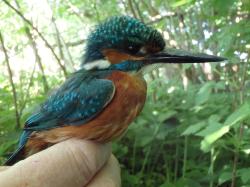Introduction

With a growing human population, habitats all over the world are affected. Besides disappearing forests and increasing agricultural areas, degradation and destruction of natural rivers is another factor of major concern (Pedroli et al. 2002). Increasing pollution leads to declining fish stocks, excess nitrogen and phosphorus from agricultural areas wash into water bodies, cause eutrophication and increase turbidity. In addition, human alterations, i.e. cutting of vegetation or straightening, deepening and paving of river sides disturb the natural flow (Pedroli et al. 2002, Tockner et al. 2010, Kristensen 2012). Those habitat alterations have a huge effect on associated species. Common otters (Lutra lutra) for example, avoid places where riparian vegetation cover has been removed, as they lack hiding possibilities (Cho et al.2009). Wild mulloway (Argyrosomus japonicus) reduce their foraging behavior with increasing boat traffic in rivers, with negative effects on their fitness (Payne et al. 2014), and European eel (Anguilla anguilla) recruitment is declining due to hydro power plants hindering their ways to their breeding grounds (McCarthy et al. 2008). Habitat loss, moreover, decreases potential nursing and breeding grounds, which can lead to increased stress especially in territorial species (Johnstone et al.2012). Dolman & Sutherland (1994) state, that in territorial birds, a loss in habitat may lead to population declines, and Stewart (Stewart et al. 2005) reports declining fecundity and physical conditions at high densities due to stress in American elks (Cervus elaphus). Different species hence need different attention, and knowledge about their reasons for decline are the first step to conserve them.
Responsible for this page:
Director of undergraduate studies Biology
Last updated:
05/11/17
